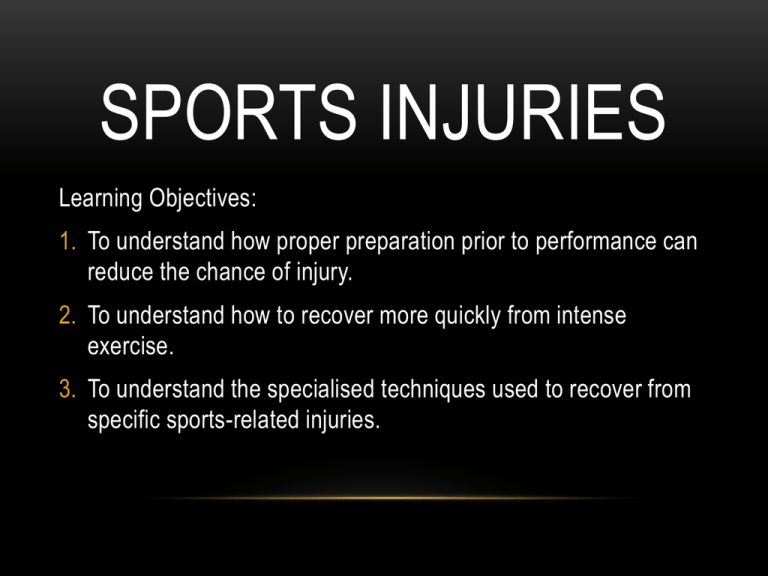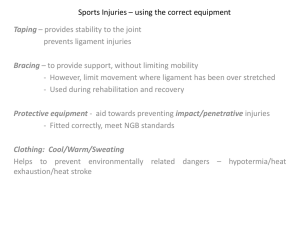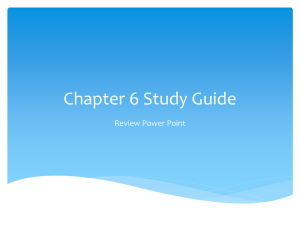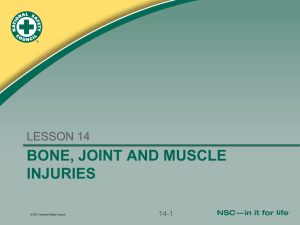File - PE Course Specification
advertisement

SPORTS INJURIES Learning Objectives: 1. To understand how proper preparation prior to performance can reduce the chance of injury. 2. To understand how to recover more quickly from intense exercise. 3. To understand the specialised techniques used to recover from specific sports-related injuries. INJURY PREVENTION PROTECTIVE EQUIPMENT • A wide variety of equipment to protect from impact injuries. • E.g. cricket - Helmet, forearm guard, box, pads, gloves. SHOES AND BOOTS • Prevent injuries such as shin splints, inflammation of Achilles tendon, blisters and lower back pain • Must provide suitable amounts of grip (friction) with ground for the particular sport. • Footwear must be correct size and type for the individual (could include analysis of stride length, running style etc). CLOTHING – TEMPERATURE REGULATION • Appropriate outdoor clothing – staying warm and dry. • Staying cool – Synthetic micro fibres allows sweat to ‘wick’ away from the body quickly. • Staying warm – wind proof, base layers etc. TAPING AND BRACING • Prevent ligament injuries, relieves muscular tension. • Knee and elbow bracing to provide extra stability around the joint. • Must be adjustable to not restrict movement INJURY PREVENTION TRAINING STRENGTH TRAINING AND CONDITIONING • Appropriate training can reduce a performer’s susceptibility to injury. • Core strength /stability exercises help to maintain correct alignment of the spine and pelvis while the limbs are moving. This makes the performer less prone to lower back injuries. • Conditioning work must be specific to the physical demands of the activity. • Strength training is the use of resistance to muscular contraction to build the strength, anaerobic endurance, and size of skeletal muscles. DANGERS OF OVER TRAINING Overtraining can be causes in 2 ways: 1. Overstressing the body during training sessions 2. Not allowing sufficient time for recovery after an intense training session Overtraining can cause: • Deep muscle soreness • Nagging injury • Not sleeping properly • Loss of appetite To avoid overtraining injuries: • Allow sufficient recovery time • Restore glycogen stores after hard sessions • Don’t train when ill. • Ensure that diet is well balanced YOUNG CHILDREN AND OVERTRAINING • Children are different physiologically, they are not miniature adults. • Overtraining of children can lead to inflammation of tendons, mild tendonitis and stress fractures. • Resistance training that is planned to the child’s developmental age and physique is recognised as safe. • Young performers are more at risk from overuse injuries during times of rapid growth. • One common overuse injury is Osgood-Schlatter’s disease (inflammation of the patella tendon) caused by repetitive running. LONG TERM ATHLETE DEVELOPMENT PROGRAMME (LTAD) • The LTAD framework aims to define optimal training, competition and recovery throughout an athlete’s career to enable him / her to reach his / her full potential in sport. • LTAD focusses on performer development but also offers valuable advice on preventing inappropriate training and coaching programmes for children. • The LTAD identifies two overlapping stages relating to children’s sport: The FUNdamental stage (5-11 yrs) focusses on fun, participation in a range of sports, fundamental motor skills, simple rules and ethics. The Learning to Train stage (8-12 yrs) focusses on developing endurance, flexibility and speed, knowledge of warm up and cool down, further development of fundamental movement skills. WARM UP AND WARM DOWN BENEFITS OF A WARM UP • Maintenance of body warmth. • Preparation of muscles and joints in more specific way than static stretching. • Improvement of motor ability. • Energising nervous system. • Mental preparation EXAMPLE OF A WARM UP • Modern day warm ups involve dynamic and active movements because this is thought to be more beneficial than static stretching. Likely features of a warm up routine are: • Cardiovascular warm up (5-10 minutes). Could be light jogging or skipping. • Performer should be focussing their mind on the performance they are preparing for. • 8-10 dynamic exercises. Should involve all major muscle groups equally. Completed in 20-30 minutes. • Followed by a light jog. • Exercises are done with an increase level of intensity. BENEFITS OF A WARM DOWN • Designed to decrease injurious effects of performance. • Prevents blood from pooling in the limbs. • Prevents lactic acid from building up in muscles. • Helps muscle tendons to relax and loosen. EXAMPLE OF A WARM DOWN • These should be static stretches. • Examples would be hamstring, quad, and triceps stretches. • With a hamstring stretch, one leg should be straight whilst the other is ben. Weight should be on the bent leg. • Each stretch should be held for at least 20 seconds. • Warm down helps to relieve DOMS (delayed onset of muscle soreness) caused by damage to muscle fibres and connective tissue particularly during intense work or eccentric contractions. ENSURING PROPER RECOVERY AFTER INJURY RICE • Rest, Ice, Compression, Elevation. Used for soft tissue injuries. • Rest: should happen as soon as the injury occurs • Ice: Reduces internal bleeding (through vasoconstriction). This reduces swelling and will speed recovery. Apply for 10-15 minutes, off for 20 minutes, then repeat. • Compression: Helps control swelling • Elevation: Helps reduce swelling and inflammation. RECOVERY FROM INTENSE EXERCISE Therapeutic massage • Releases muscle tension and restores balance to the musculo-skeletal system. Cryotherapy • Use of cooling measures used to treat chronic or acute injuries. • Ice baths are used as post-match recovery in contact sports, for the same reason ice is used for soft tissue damage • Cryogenic chambers are used, and are cooled by liquid nitrogen to temperatures of -110degrees Celsius. Used for treatment of muscle and joint pain. Patients are placed in for a few minutes . Replenishing energy stores • It is important to replenish the carbohydrate and the glycogen stores after exercise. • Performers should aim to eat 1.5-3g per KG of carbohydrates. • The goal is the consume at least 50g shortly after exercise. . SPECIAL SUPPORT FOLLOWING INJURIES CORE STRENGTH TRAINING • Carried out during the rehabilitation period • Injury is less likely to reoccur after this training. • Performer focuses on kinetic chain which is a system that consists of muscles and joints that work together to enable movement. • Rehabilitating a muscle or joint in isolation means you are more likely suffering from the same injury. WATER BASED TRAINING • Any activity performed in water to help in rehabilitation from injury. • Often used if athletes need to maintain cardiovascular fitness. • In water, the body weighs about 10% of its land weight so there is no stress put on injured joints/muscles. • Often the athlete performs a running action in the water using long strides. PHYSIOTHERAPY AND SPORTS MASSAGE • Application of massage techniques on parts of the body and is done to enhance performance. • Used to increase range of movements and reduce muscle soreness. • Promotes faster recovery from injury. PROPRIOCEPTIVE RETRAINING • Proprioception is the bodies awareness of position and posture. • This information comes from the proprioceptors in the joints. • It is possible a performers proprioception may be damaged after injury. • Performer should undergo balance board exercises and jumping drills to restore proprioception. TECHNOLOGY AND INJURY RECOVERY HYPERBARIC CHAMBERS • Hyperbaric chamber is an air tight chamber that can simulate air pressure at altitude or at depth. • It involves the inhalation of oxygen under high pressure and is undertaken in hyperbaric chambers. • Hyperbaric oxygen treatment is used as it boosts white blood cell activity in damaged parts of the body, thereby controlling infections, and constricting blood vessels and reduces blood flow to the injured region – this helps to reduce pressure and swelling. • Although some football clubs and elite athletes use the Hyperbaric Chamber Treatment, there is little research to state that it is effective in all sporting injuries. OXYGEN TENT • An oxygen tent consists of a canopy placed over the head and shoulders or over the entire body of a patient to provide oxygen at a higher level than normal. • Provides an oxygen rich environment. • Endurance athletes use oxygen tents to try and improve VO2 max or to recover from injury more quickly. • Again, research so far shows little benefit. HYPOXIC TENT • Hypoxic tent is a form of hyperbaric chamber that stimulates low pressure or altitude conditions. • It is an enclosed living space that simulates high altitude by maintaining a lower oxygen concentration. • The tent is used to stimulate the body’s natural adaptations to altitude by facilitating the production of more oxygen carrying red blood cells and haemoglobin. • This improves the athletes ability to perform work, as there is more oxygen available to the working muscles. • The problem with altitude training is that because of the oxygen concentration the athlete cannot work at their normal training load. The hypoxic tent allows the athlete to achieve some of the positive adaptations to altitude while still permitting the athlete to perform workouts at oxygen rich sea level, where their muscles can perform at their normal work level. • Research shows that this does improve endurance. EXAM REVISION QUESTIONS 1. A basketball player twists their ankle in a game and had to leave the court. (a) Describe the immediate treatment that they should use. (4 marks) Rice • Rest: Rest should happen as soon as the injury occurs. • Ice: For 10-15minutes, off for 20minutes, then repeat 10-15minutes. Helps reduce swelling by stopping internal bleeding. • Compression: Helps control swelling. • Elevation: Helps reduce swelling and inflammation. (b) The injury does not respond to the treatment. Describe two other treatments that could be used to help recovery. (3 marks) Ice baths are used as post-match recovery in contact sports, for the same reason ice is used for soft tissue damage. (reduces internal bleeding and the flow of fluids from damaged cells) Cryogenic chambers are used for treating injuries, they are cooled by liquid nitrogen to temperatures of -110degrees Celsius. Used for treatment of muscle and joint pain. Patients are placed in for a few minutes. 2. Warm Up and Warm Down are useful in preventing injury and in aiding the recovery process after intense exercise (a) What activities would you include in the warm up and why? (4 marks) • General Cardiovacular warm up for 5-10 mins • This raises core body temperature • Dynamic exercises that address all major muscle groups • This will prepare muscles for activity (b) What would you include in the warm down and why? (3 marks) • Static stretching • Helps muscles to relax and loosen, stopping them from becoming stiff • Light cardiorespiratory work • Prevents blood from pooling in the limbs • Prevents lactic acid from building up in the muscles 3. Rapid recovery from injury is vital for elite performers and they now use a wide range of injury recovery techniques. For each of the following methods describe the treatment and its purpose. A. Cryotherapy (2) • Use of cooling measures used to treat chronic or acute injuries. • Soft tissue injuries • Ice baths • Cryogenic chambers B. Proprioceptive retraining (3) Proprioception is the bodies awareness of position and posture. This information comes from the proprioceptors in the joints. Performer should undergo balance board exercises and jumping drills to restore proprioception. C. Therapeutic massage (2) Releases muscle tension and restores balance to the musculo-skeletal system Techniques are as followed: Effleurage, Petrissage, Frictions 4. For a named sport, describe the steps that a performer could take to reduce their chances of injury, prior to a competition. (7) • Hockey safety equipment- shin pads, gum shield and AstroTurf shoes • Strength training- specific to hockey. Focus on strength of leg muscles and strength of knee joint. • Preventing over training- have a training plan, make sure that you get rest and also do proper warm up and cool down. • Know what should be involved in a warm up- light aerobic exercise, dynamic activities • Knowing what should be involved in a warm down- static stretches.










